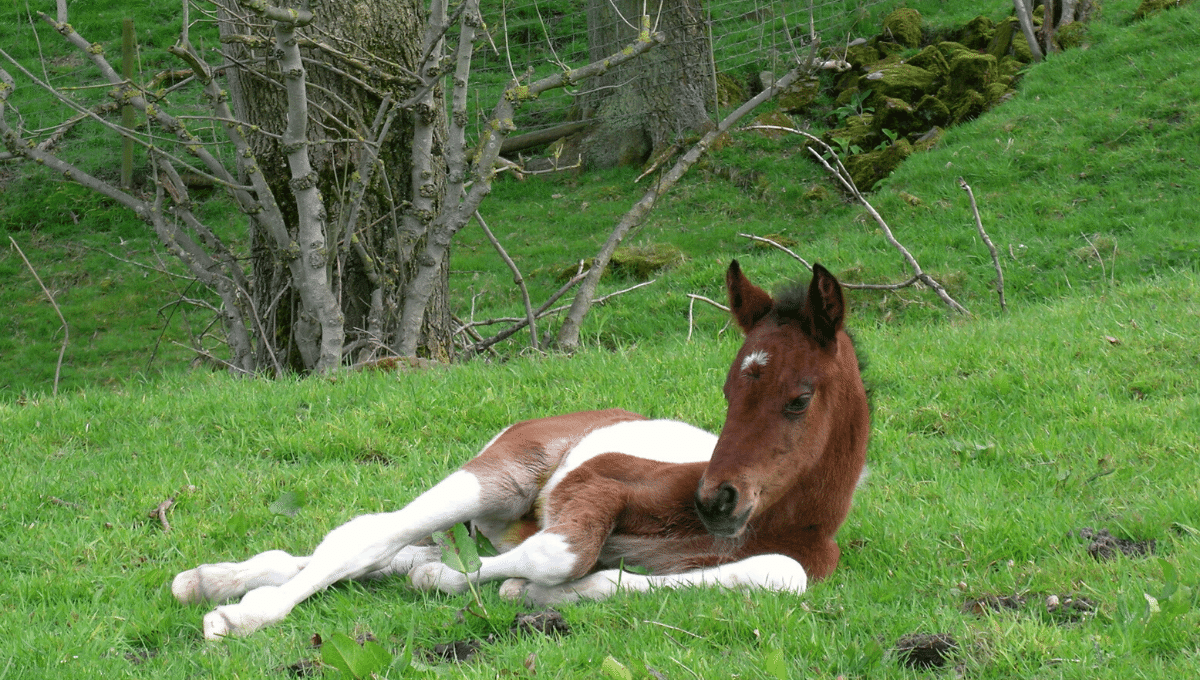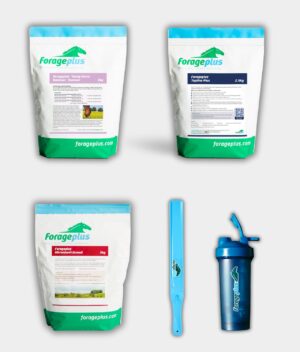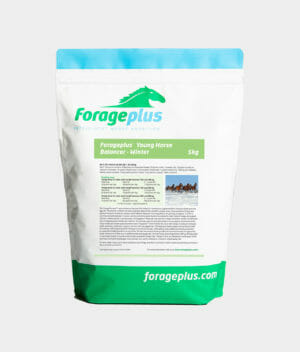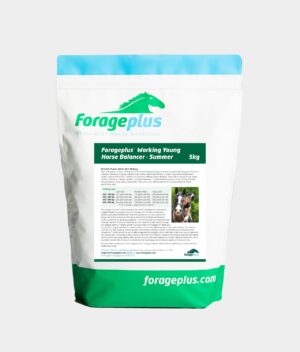Discover everything you need to know about feeding the young horse while growing up, with advice for a carefully planned approach.
Learn how to address nutritional requirements and supply adequate protein, vitamins and minerals needed to build a healthy, strong, robust and resilient body.
How should I feed a young horse?
If a horse is to grow up into an athletic and sturdy horse, then it needs to have more than just calories. As a horse owner, keeping weanlings, yearlings and young horses in good if not almost overweight body condition is the easy part. It’s easy to supply calories and that is the part most horses have fulfilled the best, but it’s only part of the picture.
The full picture is to feed optimum amounts of good quality protein and get the ratios and levels of minerals in the diet, as matched to the grass, hay or haylage that is eaten, correct. This ensures a fully balanced diet for optimal growth and adequate sources of energy when feeding the young horse.

Unless you know the nutritional quality of the forage fed, then feeding becomes guesswork. If you feed an adult daily diet to a weanling, yearling horse or youngster then you will meet calorific needs but probably fall short on nutrient requirements.
As a foundation for healthy growth and longevity, only having adequate calories is not enough. This is evidenced by the explosion of obesity in Western human society where a diet of highly processed food, high in calories and carbohydrates but low in available protein, vitamins and minerals is wreaking havoc on health, giving rise to an epidemic of chronic health issues such as heart disease, diabetes, stroke, multiple sclerosis, arthritis, thyroid problems and digestive disorders.
What does my young horse need?
Using figures from the NRC 2007 Nutrient Requirements for Horses, if you take a 6-month-old weanling and compare it to an adult horse, it needs roughly twice the calorie level per kg of body weight as an adult horse. It needs this every day but it also needs 2.5 times more protein and 4-5 times the mineral levels.
So if you are feeding the young horse the same diet as your adult horse or just hoping a weanling will eat enough hay to cover nutrition then it will not get what it needs. Neither will a yearling and neither will a young horse which is still growing.
Unless you have an understanding of the average profile of grass and hay and aim to fill in the deficiency gaps for more than just calories then your young horse will have insufficient nutrition available for the best growth.
The trouble is we are all programmed to survive. Humans brought up on a diet of mostly carbohydrates (bread, pasta, chips, breakfast cereal, noodles, rice, cakes etc.) grow into adults. They make it through their teens and perhaps into their thirties without perhaps too many health problems. Then wham bam, the chronic health problems begin. Why? Well, the evidence points to a lack of nutrients; a lack of correct fat, and a lack of quality protein, vitamins and minerals in the diet being the issue. Just Google ‘Paleo’ if you want to find out more!
Horses on the scrap heap
Sound familiar? The horse world is rife with horses that are not as structurally robust or resilient as adult horses; liver issues, poor immune systems, skin issues, lung issues, arthritis, orthopaedic disease, tendon and ligament issues, digestive problems, insulin resistance, Cushing’s etc. They are not able to keep up with the athletic demands placed upon them and many are tossed aside onto the equine scrap heap.
I want you, reading this, to start to question whether those horses, given the optimum nutrition whilst in the womb, (see Feeding the Pregnant Mare if interested in this) and then given the optimum nutrition whilst growing, would have ended up on the scrap heap?
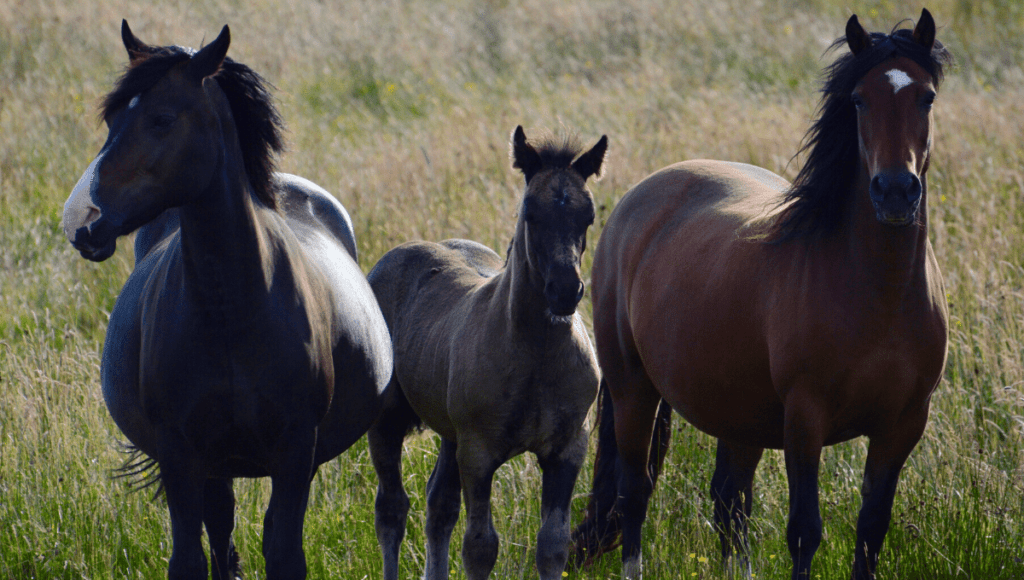
How much protein and calcium when feeding the young horse?
So to illustrate the nutrition gap many young horses are subjected to, another way, a weanling that is just under half the weight of an adult needs the same amount of calories as an adult which is a good doer and seems to live on fresh air. But, that same weanling needs 676 grams of protein per day as opposed to 540 grams for an adult good-doer with a body weight of 500 kg. If you look at calcium levels the same good doer needs 20 grams but the weanling needs 38.6 grams for healthy bone development.
If a young horse is weaned earlier than 6 months then the discrepancy is even greater between the calories needed versus protein and minerals. As the figures in the NRC are based on Thoroughbreds then you can expect a young horse, which is from a heavier genetic pool with larger bone and more muscling, will need even greater amounts than the NRC figures report. It is important to remember that these figures are only minimum requirements.
Friesians, Irish Draughts, the Shire/heavy horse crosses, Gypsy Vanners, Welsh Cobs and Quarter Horses to name but a few have a genetic predisposition to need much higher levels of protein and minerals because they are much bulkier than a Thoroughbred upon which all the NRC figures are based.
It’s about now that you should perhaps be falling off your chair in wonderment that so many horses seem to make it into adulthood on so little! But it might be why a light bulb is now shining brightly to give you the answer as to why some horses are healthy and some horses are prone to problems. It all depends on the protein and mineral start they get in life. In fact, if you do another Google search on epigenetics then you’ll find that it isn’t just what your Mum eats that makes you, it’s also what your Grandparents ate!
Different ways to supplement a young horse
There are several different ways to meet additional needs when feeding the young horse. One of the most common is to feed a high protein concentrate stud/young stock feed with a protein content of 16%. The guidelines for feeding at 1% of body weight mean that half the daily ration is intended to come from this high cereal ration. When fed in these large amounts then these feeds come close to meeting the extra protein needs and possibly, (depending upon the profile of the grass or hay mineral balance) the mineral needs. The rest of the diet will be provided by high-quality mixed grass, hay or haylage.
Does feeding a one-bag concentrate work when feeding the young horse?
The high-concentrate approach is an easy solution to the problem of feeding the young horse. A one, two, three or even four-scoop approach out of just one bag offers quick and convenient feeding but it is expensive. A larger concern has to be the VERY large proportion of calories that the young horse will be getting from starch and sugar. The high starch cereals; barley, maize and oats are usually the main ingredients in these concentrates. These are closely followed by molasses, which some companies advertise as being great for energy!
It has been very well documented that young horses on this kind of high starch, high sugar diet are likely to be at risk from glucose metabolism disturbance, compared to horses raised on a lower starch, lower sugar, high fibre diet. It has also been shown that some young horses on high sugar and or high starch diets are predisposed to exaggerated growth hormone responses which create weakened or irregular cartilage in the joints at a very young age.
The one-scoop-fits-all approach also means that calories are tied to the protein, mineral and vitamin levels. It becomes impossible to maintain a healthy weight without sacrificing the vital nutrients which support healthy growth for a robust adult horse with athletic and long-lived potential. In short, the one-bag, feed 1% of bodyweight approach is a disaster from a metabolic and joint health perspective.
When owners then cut down on the concentrate feed due to the youngster being overweight, frank deficiencies of protein and minerals and possibly certain vitamins are then created It’s a classic case of calories ruling whilst the body is starved of nutrients.

Use a forage focused approach to feeding the young horse
So what can you do when feeding the young horse for healthy and correct growth which will promote health, strength and longevity? You should understand that the younger a horse is the greater the difference between its requirements and that of an adult. Breed differences, birth dates and growth spurts mean that each young horse should be treated as an individual and the best diet should cater for additional nutrients throughout at least the yearling growth year.
Dr Eleanor Kellon wants to dispel the myth that you have to feed a high cereal/concentrate diet to grow normally and so do we at Forageplus. That high cereal, high sugar, high starch diet may well be the reason you end up with enormous vet bills sometime down the line. A ‘forage-focused’ diet which supplies sufficient fibre, essential proteins, minerals and vitamins is best. Dr Kellon says:
For as long as I can remember, it has been held as gospel that weanlings are too immature to digest fibrous feeds and hay well, and need to be fed a diet of at least 60% concentrates or grains to grow normally. Common sense alone would dictate this can’t be true or the horse would have died out as a species.
In a recent study in the Journal of Animal Science, the digestibility of various fractions of the diet was determined in mature horses, compared to weanlings on the same diet of 67% cubed forage and 33% concentrate. There were no differences.
How did this obvious myth get started? The answer is to look at the growth rate and weight instead of digestibility. Breeders want tall, ‘filled out’ weanlings and yearlings. Growth can be forced by excess calories, and what a young horse lacks in terms of muscle bulk can be covered by a layer of fat. This combination sets the stage for the failure of cartilage to mature and develop into bone properly when the young horse begins training, carrying extra condition or in some cases, even when the young horse alternates between stall confinement and turnout, and overdoes it on exercise.
Forageplus top tips for the best young horse diet
- You should feed a high protein, highly digestible feed, without going overboard on sugar and starch.
- You can use straights, alfalfa, beet pulp, micronised linseed, wheat bran or rice bran combined with high-quality hay or access to pasture. This will boost the major minerals and protein whilst providing vital omega 3.
- You might have to use soya to boost protein but there are other options such as pea protein or our newly formulated Topline plus. You might have to substitute some of your hay/haylage or grass for a high-fibre, higher protein feed if it is low in protein.
- Checking your forage by testing at least the nutritional value is imperative so you can see what protein level is available in the hay or haylage you are feeding the young horse. Many forages we test in the UK are much lower than the 8% protein an adult needs, let alone the 11% protein a young horse needs to eat. Frequently high protein forages are actually high in nitrates which means that much of the amino acids are unavailable.
- You should also, if possible, carry out a mineral analysis of the hay/haylage and grass-fed to check the balance of the minerals available to the horse. Getting the balance of calcium to phosphorous correct is essential to avoid developmental bone problems. Making sure the ratios of iron, copper, zinc and manganese are within the NRC guidelines is essential if you are to equip your horse with the building blocks for supporting healthy growth. Our testing of grass and hay shows that much higher levels of copper and zinc are indicated as being needed to balance the diet.
- Along with the straights feed a ‘forage focused’™ horse feed supplement matched to the common deficiencies in forage as evidenced by reference to forage analysis. Choose this ‘forage focused’™ horse supplement approach over a broad-spectrum vitamin and mineral supplement.
Using straights when feeding the young horse
The following table will give you an idea of different options and the proportions of each straight to use to maintain good calcium-to-phosphorous balance. They are high in protein (at least 15%) but low in sugar and starch and will compliment a ‘forage focused’™ horse feed balancer very well when fed in addition to high-quality hay, haylage and or grass. Adjust the amounts up or down to keep the ribs lightly covered but avoid a situation where your weanling or youngstock horse carries too much body fat.
| Options | Micronised Linseed | Alfalfa Pellets | Wheat Bran | Rice Bran | Beet Pulp |
|---|---|---|---|---|---|
| 1 | 115 grams | 450 grams | 450 grams | ||
| 2 | 115 grams | 450 grams | 225 grams | ||
| 3 | 115 grams | 450 grams | 450 grams | 450 grams |
Where you suspect the protein quality of grass, hay or haylage is low you may need to also supplement with extra protein. A nutritional analysis of forage will give you more information on protein levels and whether your horse needs additional supplementation with straight whey protein for horses.
Explore more of our articles on horse feeding here
You can download our latest eBook on Feeding the Young Horse for free.

